
Sicily is the largest island in the Mediterranean Sea and one of the 20 regions of Italy. It is one of the five Italian autonomous regions, in Southern Italy along with surrounding minor islands, officially referred to as Regione Siciliana.
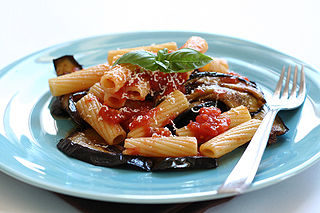
Sicilian cuisine is the style of cooking on the island of Sicily. It shows traces of all cultures that have existed on the island of Sicily over the last two millennia. Although its cuisine has a lot in common with Italian cuisine, Sicilian food also has Greek, Spanish, French and Arab influences.

Noto is a city and comune in the Province of Syracuse, Sicily, Italy. It is 32 kilometres (20 mi) southwest of the city of Syracuse at the foot of the Iblean Mountains. It lends its name to the surrounding area Val di Noto. In 2002 Noto and its church were declared a UNESCO World Heritage Site.
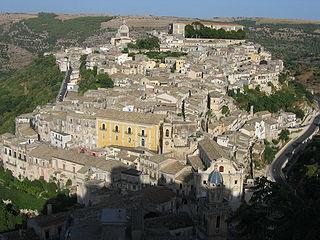
Ragusa is a city and comune in southern Italy. It is the capital of the province of Ragusa, on the island of Sicily, with 73,288 inhabitants in 2016. It is built on a wide limestone hill between two deep valleys, Cava San Leonardo and Cava Santa Domenica. Together with seven other cities in the Val di Noto, it is part of a UNESCO World Heritage Site.
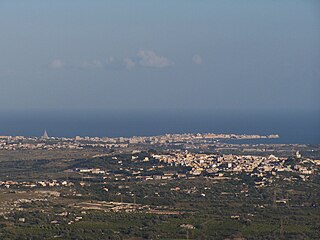
The Province of Syracuse is a province in the autonomous island region of Sicily in Italy. Following the suppression of the Sicilian provinces, it was replaced in 2015 by the Free municipal consortium of Syracuse. Its capital is the city of Syracuse, a town established by Greek colonists arriving from Corinth in the 8th century BC. It has an area of 2,109 square kilometres (814 sq mi) and a total population of 403,985 (2016). Syracuse has 8% of the Sicilian population and 8.2% of Sicily's area.

Sicilian Baroque is the distinctive form of Baroque architecture which evolved on the island of Sicily, off the southern coast of Italy, in the 17th and 18th centuries, when it was part of the Spanish Empire. The style is recognizable not only by its typical Baroque curves and flourishes, but also by its grinning masks and putti and a particular flamboyance that has given Sicily a unique architectural identity.

Rosario Gagliardi (1698–1762) was an Italian architect born in Syracuse. He was one of the leading architects working in the Sicilian Baroque. In spite of never leaving Sicily his work showed great understanding of the style, but was a progression from the style of baroque as deployed by Bernini. He worked mostly in the Sicilian Baroque beginning with the cathedral at Modica in 1702.
Giovanni Battista Vaccarini was an Italian architect, notable for his work in the Sicilian Baroque style in his homeland during the period of massive rebuilding following the earthquake of 1693. Many of his principal works can be found in the area in and around Catania.
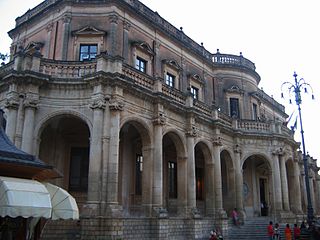
Vincenzo Sinatra was a Sicilian architect. He was a pupil of Rosario Gagliardi. Sinatra worked in both the Baroque style and later in Neo-Classical style.
Giuseppe Venanzio Marvuglia was an Italian architect.
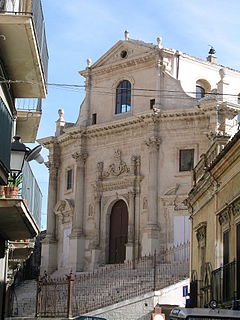
Val di Noto is a historical and geographical area encompassing the south-eastern third of Sicily; it is dominated by the limestone Iblean plateau. Historically, it was one of the three valli of Sicily.

Modica[ˈmɔːdika] is a city and comune of 54.456 inhabitants in the Province of Ragusa, Sicily, southern Italy. The city is situated in the Hyblaean Mountains.

Scicli is a town and municipality in the Province of Ragusa in the south east of Sicily, southern Italy. It is 25 kilometres (16 mi) from Ragusa, and 308 kilometres (191 mi) from Palermo, and has a population (2017) of 27,051. Alongside seven other cities in the Val di Noto, it has been listed as one of UNESCO's World Heritage Sites.
Giovanni Battista Landolina, "Marchese di S. Alfano", was a Sicilian landowner and intellectual instrumental in having the city of Noto removed from its former site on Mount Alveria to a more level location following the earthquake in 1693 centred on the Val di Noto. He is commemorated by a piazza in the city named in his honour.
Palazzo Zacco is a mansion in Ragusa, Sicily. It is most notable for the carvings in the Sicilian Baroque style which decorate its facades, especially the putti and masks which appear to support the palazzo's balconies on two of its symmetrical elevations. The palazzo was constructed circa 1750 as the townhouse for Baron Melfi di San Antonio. It was later bought by the Zacco family who renamed it after themselves as was the tradition of the time.

The 1693 Sicily earthquake struck parts of southern Italy near Sicily, Calabria, and Malta on January 11 at around 21:00 local time. This earthquake was preceded by a damaging foreshock on January 9. The main quake had an estimated magnitude of 7.4 on the moment magnitude scale, the most powerful in Italian recorded history, and a maximum intensity of XI (Extreme) on the Mercalli intensity scale, destroying at least 70 towns and cities, seriously affecting an area of 5,600 square kilometres (2,200 sq mi) and causing the death of about 60,000 people.

Italian Baroque architecture refers to baroque architecture in Italy.

Noto Cathedral is a Roman Catholic cathedral in Noto in Sicily, Italy. Its construction, in the style of the Sicilian Baroque, began in the early 18th century and was completed in 1776. It is dedicated to Saint Nicholas of Myra, and has been the cathedral of the Diocese of Noto since the diocese's establishment in 1844.

Angelo Italia was an Italian Jesuit and Baroque architect, who was born in Licata and died in Palermo.

Asmundo is an old Sicilian noble family that has played a notable role in the island's political, cultural, and economic history.


















